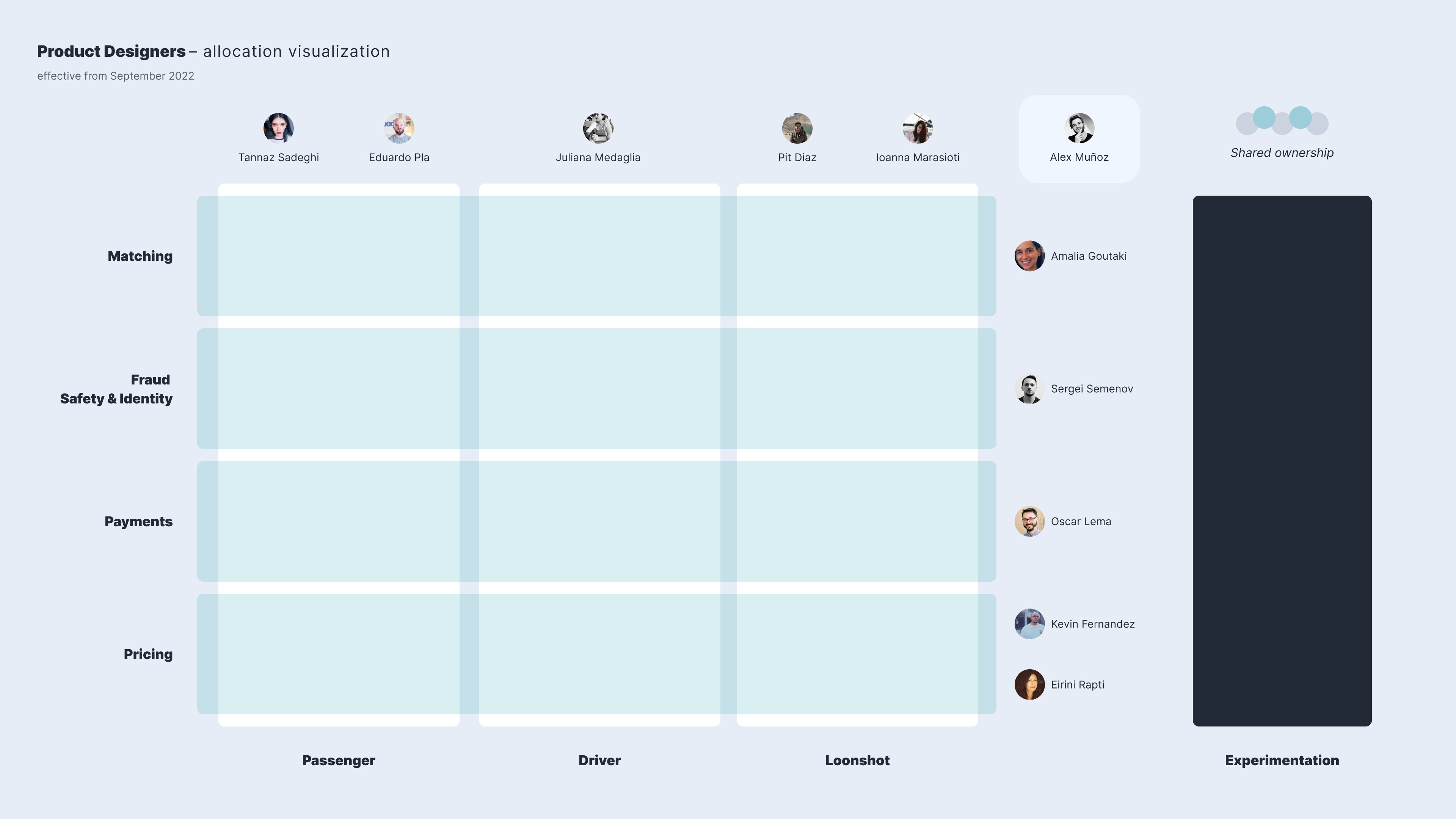
Context
Beat is a ride-hailing app competing with Uber, Cabify & Didi for the mobility market in Latin America. For almost two years (until the abrupt end of its operations), I helped the User Experience team by first managing a small squad of designers in the Driver Department and then becoming the Senior Designer Manager of the whole UX team.
My role
As a Design Manager / Lead Designer, I was responsible for mainly 2 things:
1. Making sure the designers in my team had everything they needed to do their work effectively and grow.
2. Lead the design vision, objectives and distribution of work among the UX team.
👆 In the image above
Product design team allocation during the third quarter of 2022. We were a total of 11 product designers of different experience levels and backgrounds. Due to some cost cutting during the last year of Beat, there were either 1 or 2 designers per product department, making the designer's span of impact very wide. This image illustrates the allocation and collaboration between designers in vertical and horizontal teams. The rows represent horizontal teams that work across different steps in the user journey, while the columns represent the vertical teams: those that "owned" a specific product or user base.
In a nutshell, things I learned as a design leader:
Becoming a design leader meant a big shift in focus: from being hands on to knowing when to delegate or contribute myself was a key skill that I developed through my time as a manager at Beat.
Building a strong connection that results in psychological safety with your reports is probably the most important thing you can do as a manager.
Adapting to ever-changing business circumstances or objectives is paramount for a design leader. In other words, building resilience becomes a necessity.
Navigating conflict when it arises and not coming to abrupt conclusions was one of the toughest challenges as a manager.
Optimising processes as opposed to optimising projects becomes an impact multiplier as the process replicates throughout the organisation. In every project, I asked myself: how can we replicate these changes throughout the UX team?
Building strong alliances with engineering and product from the get-go is a fruitful investment of your time as a design manager.
Establishing a vision with the product leadership team.
The situation
The senior leadership team of Beat (CEO, CPO, CMO, VP of Data…) came up with a high-level plan to inspire the almost 800 people working at Beat across Latin America & Europe. The plan was composed of 3 steps (to some extent linear):
Fixing the fundamentals.
Localise & Customise.
Moving to the future.
The task
As the new lead of the UX team, I was responsible for translating high-level, abstract company strategies to actionable plans. These actionable plans were used to inform OKRs, written by Group Product Managers.
I was responsible for increasing clarity of the step number 2 (Localise & Customise). As the Lead Designer, I worked with the Lead Researcher and Chief Product Officer to establish an actionable plan for the different product departments to execute on.
Problem statement
How might we build a localised experience for our drivers & passengers across Latin America that is differentiated from the already established competitors?
Some questions we had to answer through this initiative were:
What does it mean to localise and customise?
What are the outputs we are looking accomplish as a company?
How are we going to accomplish those outputs?
The actions I took to accomplish the task:
I set up a couple of small sessions with the CPO and Lead Researcher to define the problem statement and scope of our efforts.
I led, together with the Lead Researcher, a 3 hour in-person workshop that aimed to use the collective brain and diversity of skills to accomplish a better understanding of the company objective Localise & Customise.
I gave a presentation to set the expectations and put everybody on the same page regarding what localise & customise could mean for us.
I came up with several exercises that we did in groups, during the in-person workshop. These exercises took into account our current user base, their needs according to qualitative research, and their pain points according to our latest data.
The results of this workshop
✅
The Product Leadership Team (Chief Product Officer, Group Product Managers, Senior Product Managers) agreed upon a definition of Localise & Customise.
We came up with different, actionable examples of what it could mean for us as a business to localise our product to the different markets in Latin America. For example: adapting our app to business commuters.
✅
We inspired and informed the different product verticals to implement initiatives that were born on this workshop within their upcoming OKRs.
✅
Conclusions
Working as a design manager was one of the most enriching experiences of my career thus far. Growing other designers, optimising processes and rituals, multiplying impact, constant context switching… it makes you a better professional in many ways.
Destination Filter
How we increased our drivers’ availability by enabling them to get rides and earn money while going towards a certain destination.







